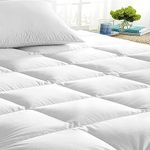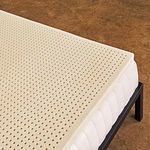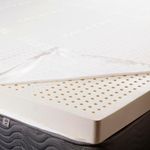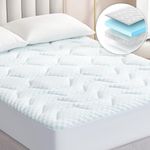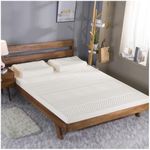Buying Guide for the Best Latex Mattress Toppers
Choosing the right latex mattress topper can significantly enhance your sleeping experience by providing additional comfort and support. Latex mattress toppers are known for their durability, natural materials, and ability to conform to your body shape, offering a balance between softness and firmness. When selecting a latex mattress topper, it's important to consider various specifications that will affect your comfort and the topper's performance. Understanding these key specifications will help you make an informed decision that aligns with your personal sleep preferences and needs.Material TypeLatex mattress toppers can be made from natural latex, synthetic latex, or a blend of both. Natural latex is derived from rubber tree sap and is known for its eco-friendliness, durability, and hypoallergenic properties. Synthetic latex, on the other hand, is made from petrochemicals and tends to be less expensive but may not offer the same level of durability or environmental benefits. A blend combines both types to balance cost and performance. If you prioritize sustainability and natural materials, opt for a natural latex topper. If budget and durability are more important, a synthetic or blended option might be suitable.
Firmness LevelThe firmness of a latex mattress topper affects how it feels and supports your body. Firmness levels typically range from soft to extra firm. A soft topper provides a plush, cushioning feel, ideal for side sleepers or those who prefer a softer surface. A medium firmness is versatile and suits most sleeping positions, offering a balance of comfort and support. Firm toppers are better for back or stomach sleepers who need more support to maintain proper spinal alignment. Consider your sleeping position and personal comfort preference when choosing the firmness level.
ThicknessThe thickness of a latex mattress topper can range from 1 to 4 inches or more. Thicker toppers provide more cushioning and can significantly alter the feel of your mattress, making them ideal for those who need extra pressure relief or want to rejuvenate an older mattress. Thinner toppers offer subtle changes and are suitable for those who want to slightly adjust the firmness of their mattress without a drastic change. Consider how much change you want in your mattress feel and your specific comfort needs when selecting the thickness.
DensityDensity refers to the weight of the latex per cubic foot and is an indicator of the topper's durability and support. Higher density latex toppers are more durable and provide better support, making them ideal for heavier individuals or those who prefer a firmer feel. Lower density toppers are softer and may be more comfortable for lighter individuals or those who prefer a plush feel. Consider your body weight and desired level of support when choosing the density of your latex mattress topper.
Ventilation and BreathabilityVentilation and breathability are important for maintaining a comfortable sleeping temperature. Latex mattress toppers often feature pinholes or other designs to enhance airflow and prevent heat buildup. This is particularly important for hot sleepers or those living in warmer climates. If you tend to sleep hot, look for a topper with good ventilation features to ensure a cooler sleeping experience.
Allergen ResistanceLatex is naturally resistant to dust mites, mold, and mildew, making it a great choice for allergy sufferers. However, some people may have latex allergies, so it's important to ensure that the topper is made from hypoallergenic materials if this is a concern. If you have allergies, prioritize a natural latex topper with certifications for allergen resistance to ensure a healthier sleep environment.


